 Earwax. We all have it, many people find it disgusting, and everyone wants to know: “what is the best way to clean my ears?” Most people seem to be very concerned about cleaning their ears and getting rid of their earwax. The only problem is that earwax serves a very important and beneficial purpose. That isn’t to say that too much ear wax isn’t a problem, because it can be. But when too much earwax becomes the problem, there are certain ways to safely clean your ear.
Earwax. We all have it, many people find it disgusting, and everyone wants to know: “what is the best way to clean my ears?” Most people seem to be very concerned about cleaning their ears and getting rid of their earwax. The only problem is that earwax serves a very important and beneficial purpose. That isn’t to say that too much ear wax isn’t a problem, because it can be. But when too much earwax becomes the problem, there are certain ways to safely clean your ear.
Let’s start off by talking about what earwax is.
Technically known as cerumen, ear wax is a secretion from glands located within the outer third of the ear canal. This is the cartilaginous portion of the ear canal. That means there is a layer of cartilage under the skin that allows that part of the ear canal to move. The inner portion of the ear canal does not have any cartilage, it is skin on top of bone. Earwax most commonly is a moist, waxy, goldish colored substance. However, the color and texture can change from person to person. Cerumen is important to the health of our ears. Firstly, it moistens the skin of the ear canal. Dry skin can become itchy and bothersome, causing you to scratch inside your ear canal. Secondly, the sticky factor of the ear wax traps dirt and debris and prevents it from getting down to the eardrum where it can potentially damage the fragile membrane. Finally, cerumen helps to clean the ear canal. As we move our jaw when we talk or yawn or chew, the ear canal changes shape and helps the cerumen to migrate towards the opening of the ear, taking dirt and debris with it, where it is easily wiped away when we clean our face or shower.
Ideally, the system works and we never have to worry about having our ears cleaned. In fact, too much cleaning can be unhealthy and dangerous. If there is too little earwax then the skin of the ear canal can become dry and itchy. If you scratch your ear you run the risk of creating a sore which can become a site of infection. You want to avoid using rubbing alcohol or other harsh chemicals to clean your ears for that reason. Without the waxy barrier present to stop things from entering the ear canal, you can end up with dirt, debris, bugs, etc. too close to the eardrum. Another “no-no” is the infamous q-tip. Yes, it feels good when we rub our ears with q-tips. However, the earwax typically gets pushed further into the ear, down into the bony portion where it won’t be able to be moved when we move our jaw. Plus, the cotton fibers will get stuck in the wax as it is being pushed in resulting in the wax sitting near the ear drum, drying out and becoming like a brick that will be painful to remove. Finally, if you push the cotton swab too far into your ear you can accidently rupture the eardrum and even possibly dislocating the tiny bones located in the middle ear. Aside from being extremely painful, this would result in a decrease in hearing that could potentially require surgical correction.
Too much ear wax can also be problematic in that is can “clog” up the ear canal and result in decreased hearing.
People who have very small ear canals may seem to produce more wax than other people. In reality, they are just producing a normal amount, but in a smaller area that can result in a wax impaction. People who wear earplugs frequently or who wear hearing aids may also seem to produce more wax and may be more prone to wax impactions. What is really happening is that because the person has something in their ear canal (the hearing aid or the ear plug), the wax, which normally moves to the opening of the ear canal when we move our jaw, now stops or “gets stuck” at the end of the ear piece or ear plug where it can develop into an impaction. People who wear hearing aids or ear plugs regularly may find that they will need to visit their physician for routine ear cleaning.
Earwax removal is best left to the experts. Home treatments can be uncomfortable or even dangerous. If you think you have too much ear wax and it is affecting your hearing, you should call our office and schedule an appointment with one of our medical professionals. They can examine your ear, and provide the safest, most appropriate method of wax removal if necessary.